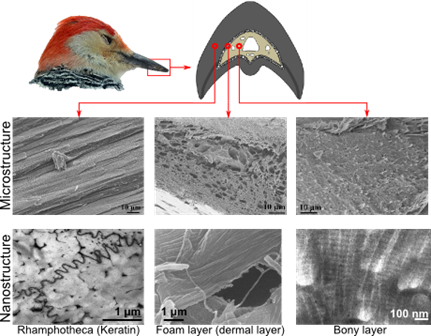Integrated Computational Materials Engineering (ICME)
Biomaterials
Overview
We provide the information and data of the structure-properties relationship for biological materials from various kinds of living creatures including fish, birds, mammals, and human tissue, and of engineering designs and principles inspired from biological materials.

One example of biological material. Micro and nano structure of three-layered woodpeckers' beaks showing hierarchical structure of biological materials. [1].
Biological Materials
Biological materials are the materials used in living tissue including human, animal, and vegetation. Most biological materials are much stronger than the individual constituents they are made of. They typically have a low density, contain no metals, and have hierarchical organization inherent in their design of both structure and material. Most are multifunctional, self-healing, self-organizing, and self-assembling. They also have a broad range of both Young's moduli, strength, and toughness varying over several orders of magnitude[2]. The structure-property relationships of biological materials can provide data and information to carry out modeling/simulations for the human body and bio-inspired design ideas.
Bio-inspired Design
Bio-inspired design, also called biomimetics or biomimicry, is the study of living species for the purpose of creating new engineering systems since biological materials present many examples of unique structures, which provide numerous sources for novel structural material designs. In order to mimic structure to design mechanical system, some animals, plants, or human organs are observed experimentally and simulated using computational modeling at different length scales. Compared to man-made materials, biological materials have three characteristics. First, biological materials are designed to be function-oriented; therefore, their structures are optimized for their function. Second, biological materials are generated from the lowest length scales in a cell. Third, they are organized hierarchically down to the nanoscale. With regard to these characteristics, ICME can be a proper tool to model and simulate biological materials, which can be more complex than man-made materials are. ICME enables to catch up the properties of biological materials from the nanoscale to macroscale and to bring meaningful data with low uncertainty to the tissue level model. Studying these materials at different length scales allows the determination of the hierarchical structure interaction. Several examples of successful bio-inspired designs include velcro, modeled after seed burrs, and hexagonal armor plates modeled after abalone nacre.
Reference
1. Lee, N., Horstemeyer, M., Rhee, H., Nabors, B., Liao, J., Williams, LN.,
“Hierarchical multiscale structure–property relationships of the red-bellied
woodpecker (Melanerpes carolinus) beak,” Journal of The Royal Society
Interface, 11 (2014) 20140274. (http://rsif.royalsocietypublishing.org/content/11/96/20140274)
2. Meyers MA, Chen P-Y, Lin AY-M, Seki Y. Biological materials: Structure and
mechanical properties. Progress in Materials Science 2008;53:1–206.
